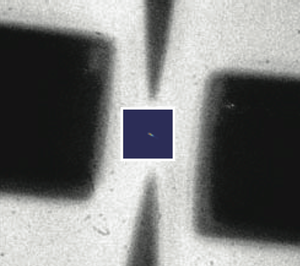Optical Fibers Illuminate Single Ion
A single ion and a single photon barely interact on their own, but a research team played matchmaker to the shy pair, significantly strengthening the particles’ interactions. As they report in Physical Review Letters, the researchers adapted an experiment previously performed only with neutral atoms. They trapped a single ytterbium ion in the small gap between two optical fibers whose ends acted as mirrors that enhanced the ion’s ability to absorb and emit a single photon. This enhanced interplay—demonstrating one of the world’s smallest optical cavities for ions—could be a step toward quantum computers and quantum networks that store information in ions and move that information around using light.
Many researchers would like to use ions as quantum bits, the building blocks of a hypothetical quantum computer that could outperform conventional computers. Scaling up the small assemblies of trapped ions created thus far might involve transferring quantum states from ions to photons, which could transport the information to distant ions. Researchers get an ion and a photon to interact using an optical cavity, which consists of a pair of closely spaced mirrors that enhance the reflection of a specific wavelength of light. For efficient and reliable ion-photon interactions, the ideal is so-called strong coupling, in which the ion continually absorbs and emits a single photon at a rate faster than the rates for competing processes that sap energy (such as the photon escaping the cavity).
Researchers have achieved strong coupling with neutral atoms, but ions are the particles for which they have developed a rich variety of quantum computing components, such as logic gates. In pursuit of strong ion-photon coupling, Michael Köhl of the University of Cambridge, Jakob Reichel of the École Normale Supérieure and the Pierre and Marie Curie University in Paris, and their colleagues, modified a cavity that Reichel previously developed for neutral atoms. The problem for ions has been that errant charges tend to accumulate on cavity mirrors and nudge the ion away from its position in the cavity, which is maintained by electric fields. Reichel’s neutral atom cavity, which used the reflective ends of two optical fibers separated by tens of microns [1], held promise for ions because those Lilliputian mirrors offer little surface area for the buildup of stray charge. For the ion version, the team added metal sleeves on the fibers to block stray ultraviolet light, which could generate charge in the fiber material.
In the team’s experiments, a positive ytterbium ion sat happily in the 230-micron gap between the mirrors for 30 minutes, held in place by an electric field. The team first cooled the ion with one laser and then excited its electrons with another. The excited atom could then lower its energy and drop to a new state by emitting a photon with the cavity’s preferred wavelength. The researchers determined the frequency at which the ion would emit and then reabsorb this photon ( 3.4 megahertz) and found that it was almost twice as high as the rate for the ion to lose energy by emitting a photon of the “wrong” wavelength. This high rate of interaction with the photon fulfilled one of the two main criteria for strong coupling.
“This is really significant and hasn’t been done before with ions,” says Tracy Northup of the University of Innsbruck in Austria. However, she cautions that the other requirement for strong coupling in a cavity remains unfulfilled: The lifespan of each photon in the cavity was shorter than the cycling time for the ion’s absorption and emission of the cavity photon, thanks to imperfections in the microscopic mirrors. To reach true ion-photon strong coupling, the matchmakers will need to repeat the experiment with better mirrors.
–Devin Powell
Devin Powell is a freelance science writer in Washington, D.C.
References
- J. Volz, R. Gehr, G. Dubois, J. Estève, and J. Reichel, “Measurement of the Internal State of a Single Atom Without Energy Exchange,” Nature 475, 210 (2011)





